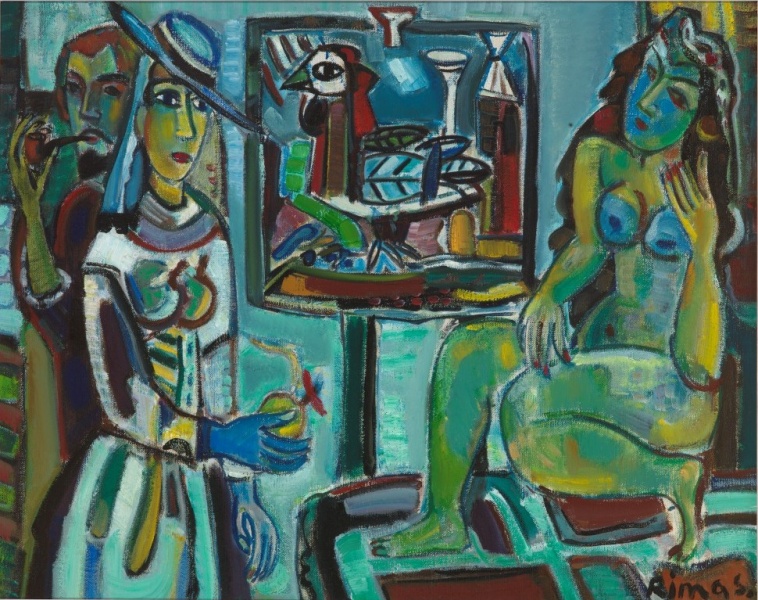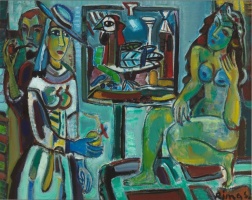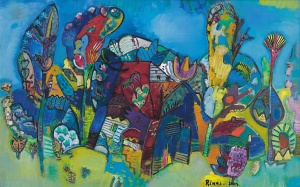

Self-portrait with Muse
| Author: | Rimas Bičiūnas (b. 1945) |
The painter Rimas Zigmas Bičiūnas, the son of the folk artist Monika Bičiūnienė, was born on 13 August 1945 in the village of Panemunis in the Rokiškis district. He attended the National M.K. Čiurlionis School of Arts from 1961 to 1966. Between 1966 and 1972, he studied painting at the Lithuanian State Institute of Art under Professor Antanas Gudaitis. He began to participate in exhibitions in 1973, and in 1975 he became a member of the Lithuanian Artists’ Association. Between 1971 and 2011, he ran the Paletė art studio at the Taurakalnis Cultural Centre in Vilnius.
He has held more than ten solo art exhibitions, and has participated in many group art exhibitions in Lithuania, and 34 art exhibitions abroad, in France (1982, 1994, 2010), Italy (1982, 2001), India, Japan (1982), Switzerland (1983, 1998, 2000), Poland, Hungary (1987), Germany (1988, 1990–1991, 1993, 1999, 2002), Finland (1989), Great Britain (1989, 1999–2000), Turkey (1999), the USA (1990, 1995), Holland (1999), and China (2002). He was awarded a prize by the Ministry of Culture for his pictorial art in 1984, a prize by the G. Kazokienė Fine Arts Foundation in 1997, the Miklos Kaplar Prize in Hungary in 1987, and a diploma from the art competition Peinture Floralies in France in 1997. His work has been displayed next to works by Picasso, Chagall and other famous artists.
Works by Rimas Bičiūnas have been acquired by the Lithuanian Art Museum, the M.K. Čiurlionis National Art Museum, the Klaipėda Art Gallery, the Rokiškis Regional Museum, the national art galleries of Latvia, Georgia, Bulgaria and Slovakia, the ministries of culture of the Republic of Poland and the Czech Republic, the Dr P. Ludwig Museum of Modern Art in Cologne, and the State Tretyakov Gallery in Moscow.
Rimas Bičiūnas’ art is a feast of colour. His pictures emanate a feeling of free improvisation and unrestricted liberty, and an impression of lightness. They are painted as skilfully as if they were created very suddenly. Colour plays an extremely important role in his work. Just as the strength of music lies in the variety of the sounds, the strength of a picture lies in the spectrum of colours. According to Bičiūnas, lines and colour can create a melody. His works are characteristic of the Expressionist style of painting, with a deformation of shapes, combinations of bright and contrasting colours, and optimism. The stylisation, despite being professional and skilful, recalls the artifice of Lithuanian folk art. Only on a closer look is it possible to discern the image, with motifs with symbolic meanings: the blossoming trees, palms, hills, artistically decorated houses and plants all seem to emerge from old tales.
Source: Valiunas Ellex (LAWIN until 2015) art album: THE WORLD OF LANDSCAPES II (2013). Compiler and author Nijolė Tumėnienė.

The painter Rimas Zigmas Bičiūnas, the son of the folk artist Monika Bičiūnienė, was born on 13 August 1945 in the village of Panemunis in the Rokiškis district. He attended the National M.K. Čiurlionis School of Arts from 1961 to 1966. Between 1966 and 1972, he studied painting at the Lithuanian State Institute of Art under Professor Antanas Gudaitis. He began to participate in exhibitions in 1973, and in 1975 he became a member of the Lithuanian Artists’ Association. Between 1971 and 2011, he ran the Paletė art studio at the Taurakalnis Cultural Centre in Vilnius.
He has held more than ten solo art exhibitions, and has participated in many group art exhibitions in Lithuania, and 34 art exhibitions abroad, in France (1982, 1994, 2010), Italy (1982, 2001), India, Japan (1982), Switzerland (1983, 1998, 2000), Poland, Hungary (1987), Germany (1988, 1990–1991, 1993, 1999, 2002), Finland (1989), Great Britain (1989, 1999–2000), Turkey (1999), the USA (1990, 1995), Holland (1999), and China (2002). He was awarded a prize by the Ministry of Culture for his pictorial art in 1984, a prize by the G. Kazokienė Fine Arts Foundation in 1997, the Miklos Kaplar Prize in Hungary in 1987, and a diploma from the art competition Peinture Floralies in France in 1997. His work has been displayed next to works by Picasso, Chagall and other famous artists.
Works by Rimas Bičiūnas have been acquired by the Lithuanian Art Museum, the M.K. Čiurlionis National Art Museum, the Klaipėda Art Gallery, the Rokiškis Regional Museum, the national art galleries of Latvia, Georgia, Bulgaria and Slovakia, the ministries of culture of the Republic of Poland and the Czech Republic, the Dr P. Ludwig Museum of Modern Art in Cologne, and the State Tretyakov Gallery in Moscow.
Rimas Bičiūnas’ art is a feast of colour. His pictures emanate a feeling of free improvisation and unrestricted liberty, and an impression of lightness. They are painted as skilfully as if they were created very suddenly. Colour plays an extremely important role in his work. Just as the strength of music lies in the variety of the sounds, the strength of a picture lies in the spectrum of colours. According to Bičiūnas, lines and colour can create a melody. His works are characteristic of the Expressionist style of painting, with a deformation of shapes, combinations of bright and contrasting colours, and optimism. The stylisation, despite being professional and skilful, recalls the artifice of Lithuanian folk art. Only on a closer look is it possible to discern the image, with motifs with symbolic meanings: the blossoming trees, palms, hills, artistically decorated houses and plants all seem to emerge from old tales.
Source: Valiunas Ellex (LAWIN until 2015) art album: THE WORLD OF LANDSCAPES II (2013). Compiler and author Nijolė Tumėnienė.







